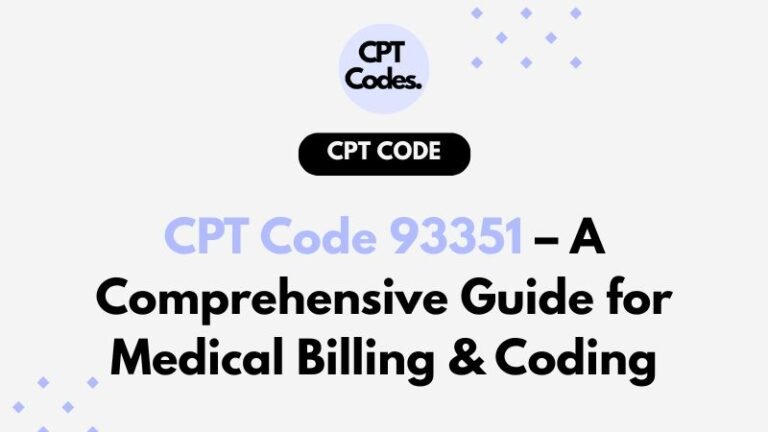CPT Code 93351 is a vital billing code in cardiology, representing a combined stress test and echocardiographic imaging service. This code ensures accurate reimbursement for a complex diagnostic test that evaluates heart function both at rest and under stress. Proper understanding of CPT 93351 helps medical billers, coders, and healthcare providers avoid denials and comply with payer requirements.
What Is CPT Code 93351?
CPT 93351 describes a transthoracic echocardiography (2D imaging, and M-mode if performed) conducted at rest and during a cardiovascular stress test—either exercise-based or pharmacologic. The code includes continuous ECG monitoring, physician supervision, and interpretation with a written report.
In simpler terms, CPT 93351 represents the complete stress echocardiogram, combining both imaging and stress testing into a single, globally billable procedure.
Category & Code Type
- Category: Echocardiography Procedures (Cardiology Section)
- Code Type: Global procedural code, which includes both the technical and professional components when performed in a non-facility setting.
This means CPT 93351 covers all aspects of the stress echocardiogram — from image acquisition to physician supervision and final interpretation.
Coding Criteria for CPT 93351
To bill CPT 93351 correctly, the following must be documented:
Required Conditions
- Resting echocardiogram and stress-phase echocardiogram (exercise or pharmacologic) are both performed.
- Continuous ECG monitoring is documented during the stress portion.
- Physician supervision and interpretation are clearly stated in the record.
- Imaging includes global and regional wall motion assessment, valvular evaluation, and cardiac function changes under stress.
- There is a clear medical necessity, such as evaluation of ischemia, chest pain, or shortness of breath on exertion.
Common Clinical Use Cases
- Suspected ischemic heart disease or angina.
- Valvular disease assessment (e.g., aortic stenosis under stress).
- Post-myocardial infarction recovery and exercise capacity evaluation.
- Pre-operative cardiac risk assessment.
CPT 93351 vs CPT 93350 – What’s the Difference?
Both CPT 93350 and CPT 93351 are stress echocardiogram codes, but they are not interchangeable.
| Feature | CPT 93350 | CPT 93351 |
|---|---|---|
| Includes ECG monitoring | No | Yes |
| Physician supervision of stress test | Not included | Included |
| Global service (technical + professional) | Typically separate | Yes |
| Used in | Facility or hospital (partial service) | Office/non-facility (complete service) |
In short, CPT 93351 is a comprehensive code that includes all components — imaging, ECG monitoring, supervision, and interpretation — while CPT 93350 only covers the imaging portion without ECG monitoring or supervision.
Billing Guidelines for CPT 93351
Core Billing Rules
- Global billing: Use CPT 93351 without a modifier if both technical and professional components are performed.
- Professional component: Append modifier 26 when only the interpretation/report is performed.
- Technical component: Append modifier TC when only equipment and staff services are provided.
- Contrast use: Add CPT 93352 if an echocardiographic contrast agent is used during the test.
- Avoid unbundling: Do not bill CPT 93351 with CPT 93015 (standard stress test) or other overlapping cardiovascular codes.
Payer & Compliance Considerations
- Ensure the ICD-10 diagnosis supports medical necessity (e.g., chest pain, shortness of breath, ischemic heart disease).
- Verify payer policies for site of service (facility vs non-facility).
- Confirm whether split-billing (26/TC) is permitted.
- Check for local coverage determinations (LCDs) that define approved indications.
Documentation Tips
- Document both rest and stress echo phases clearly, including ECG monitoring.
- Include the protocol used, target heart rate, and any reasons for early test termination.
- Record the physician’s supervision statement and full interpretation/report.
- Note any contrast use, including name, dose, and purpose.
- Make sure the medical indication (e.g., chest pain evaluation) is evident in the record.
Common Examples of CPT 93351 Use
- Patient with chest pain: A cardiologist performs a treadmill stress echo with ECG monitoring and interprets the results — bill CPT 93351.
- Aortic stenosis evaluation: A patient’s valve function is assessed at rest and under pharmacologic stress — bill CPT 93351.
- Post-heart attack risk assessment: Used to evaluate residual ischemia before cardiac rehab — bill CPT 93351.
Common Mistakes & Denials
- Using CPT 93351 without documenting continuous ECG monitoring.
- Billing 93351 with 93015 (duplicate stress testing codes).
- Failing to document physician supervision.
- Missing medical necessity or appropriate ICD-10 diagnosis.
- Forgetting to append modifier 26 or TC when billing separately.
- Omitting CPT 93352 when contrast was used.
Key Takeaways
- CPT 93351 = Complete stress echocardiogram (imaging + ECG + supervision + interpretation).
- Always ensure documentation supports rest and stress phases with ECG monitoring.
- Use correct modifiers (26, TC) based on billing components.
- Do not pair 93351 with overlapping stress test codes (e.g., 93015).
- Verify payer LCDs for covered diagnoses to prevent denials.
FAQ
Q1: What is CPT 93351 used for?
It’s used to bill for a complete stress echocardiogram performed with both echocardiographic imaging and ECG monitoring under physician supervision.
Q2: How is CPT 93351 different from CPT 93350?
CPT 93350 only includes the echocardiographic imaging, while CPT 93351 bundles ECG monitoring and physician supervision for a full stress echo procedure.
Q3: Can CPT 93351 be billed with CPT 93015?
No. The ECG stress test portion is already included in CPT 93351, so billing both would be unbundling.
Q4: What modifiers apply to CPT 93351?
Use 26 for professional interpretation only, TC for technical service only, or no modifier for global billing.
Q5: When should CPT 93352 be used with 93351?
Add CPT 93352 when an echocardiographic contrast agent is used during the stress echo, with proper documentation.
Q6: What diagnoses justify CPT 93351?
Common indications include chest pain, dyspnea, suspected ischemia, valvular heart disease, or cardiac risk evaluation before surgery.
Summary
CPT Code 93351 represents a complete stress echocardiogram, which includes both echocardiographic imaging (at rest and during stress), continuous ECG monitoring, physician supervision, interpretation, and report. It’s a global code covering both technical and professional components when performed in-office or non-facility settings.

